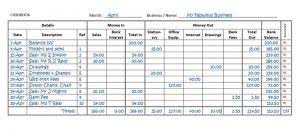
Moving forward, the evolution of GAAP will continue to be shaped by changing business practices, regulation, and stakeholder requirements. International public companies also frequently report financial statements in accordance with International Financial Reporting Standards (IFRS). The landscape of financial regulations is constantly evolving due to technological advancements, changes in the global economy, and increasing demands for transparency. A “basic view” version is free, while the more comprehensive “professional view” is available by paid subscription. Some may question whether traditional accounting principles remain relevant in today’s rapidly changing business environment. The rise of digital currencies, blockchain technology, & artificial intelligence is reshaping how businesses operate and report their financial information.
- This includes guidance on training, technology tools, and professional networks that can support ongoing education and adherence to financial regulations.
- Moreover, regular training sessions can serve as a platform for discussing real-world scenarios and case studies.
- If a corporation’s stock is publicly traded, its financial statements must follow rules set by the U.S.
- By integrating these regulations into their practices, accountants can help safeguard their firms and clients against potential financial crimes.
- GAAP (Generally Accepted Accounting Principles) is a comprehensive set of rules and standards that regulate financial reporting and accounting practices in the United States.
ACCOUNTING for Everyone

The SEC mandates that publicly traded companies in the U.S. file GAAP-compliant financial statements regularly to maintain their public listing on stock exchanges. GAAP compliance is verified through an appropriate auditor’s opinion, resulting from an external audit by a certified public accounting (CPA) firm. The most notable principles include the revenue recognition principle, matching principle, materiality principle, and consistency principle. Completeness is ensured by the materiality principle, as all material transactions should be accounted for in the financial statements. In conclusion, GAAP plays a vital role in ensuring clear, consistent, and transparent financial reporting for both publicly traded companies and governmental entities. However, the specific application of GAAP principles differs between the two, addressing the unique requirements and operations of each entity type.
Standard IFRS Requirements
He is an expert on personal finance, corporate finance and real estate and has assisted thousands of clients in meeting their financial goals over his career. Even though the company won’t pay the bill until August, accrual accounting calls for the company to record the transaction in July, debiting utility expenses. For example, the current ratio compares the amount of current assets with current liabilities to determine how likely a company is going to be able to meet short-term debt obligations.
- These courses can cover areas such as tax compliance, financial reporting standards, and risk management.
- A deep knowledge of these regulations is essential for ensuring that financial practices align with legal requirements.
- Finally, continuous education and training are paramount for accountants to stay ahead of compliance challenges.
- Also, the SEC has broad power over accounting and financial reporting standards for companies whose securities (stocks and bonds) are publicly traded.
- Companies that adopted SOX compliance measures demonstrated improved internal controls and transparency, ultimately restoring investor confidence.
C. Ensuring accurate financial reporting
Each principle is meant to guarantee and support clear, concise and comparable financial reporting. Any financial statement must accurately reflect all of the company’s assets, expenses, liabilities and other financial commitments. GAAP must always be followed by accountants and businesses when handling financial information.
- By prioritizing compliance education, firms can cultivate a workforce that is not only compliant but also engaged and motivated to uphold ethical standards.
- They must be adept at interpreting complex financial data and identifying discrepancies or potential areas of risk.
- A balance sheet using this system might show a higher stream of revenue than a GAAP version of the same balance sheet.
- Chief officers of publicly traded companies and their independent auditors must certify that the financial statements and related notes were prepared in accordance with GAAP.
- Ultimately, a commitment to financial compliance is a cornerstone of sustainable business growth and success.
- A business may resort to “creative” accounting to make profit for the period look better or to make its year-to-year profit less erratic than it really is (which is called income smoothing).
Additional Guidelines

Companies that adopted SOX compliance measures demonstrated improved internal controls and transparency, ultimately restoring investor confidence. Many software solutions offer features such as the standards and rules that accountants follow while recording and reporting financial activities real-time reporting, audit trails, and compliance checklists. These functionalities help accountants monitor their financial activities and ensure that all transactions adhere to regulatory requirements. By utilizing these tools, accountants can focus more on strategic decision-making rather than getting bogged down by compliance issues. Furthermore, training and communication play a vital role in the implementation of internal controls.
A. Definition of financial compliance

The International Accounting Standards Board (IASB) establishes and interprets the international communities’ accounting standards when preparing financial statements. There are upwards of 7,000 public companies in the United States and more than 1 million privately owned businesses. Should all these businesses use the Bookkeeping for Chiropractors same accounting methods, terminology, and presentation styles for their financial statements? Furthermore, accountants have to interpret the rules as they apply GAAP in actual situations. GAAP (Generally Accepted Accounting Principles) is a comprehensive set of rules and standards that regulate financial reporting and accounting practices in the United States. These guidelines ensure consistency, comparability, and integrity in business financial statements.

GAAP-compliant accountants are committed to accuracy and impartiality, applying consistent standards throughout the financial reporting process. Key concepts include regulatory requirements, internal controls, financial reporting standards, and ethical practices. Understanding these terms is essential for navigating the compliance landscape effectively. A key component of a compliance framework is the identification of relevant regulations and standards that apply to the organization. Accountants must stay informed about local, national, and international financial regulations to ensure that their practices align with legal requirements. Finally, maintaining open communication with regulatory bodies is crucial for staying recording transactions informed about compliance requirements.